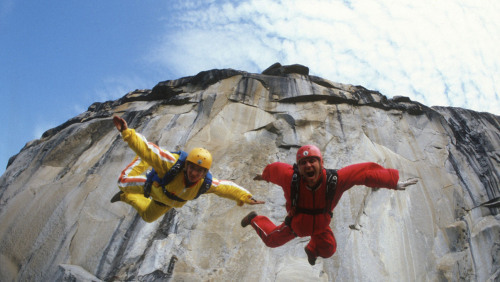Perhaps Carl Boenish had a premonition that he would die young.
Not that he was a gloomy sort. A legendary thrill-seeker and pioneer of the sport of BASE jumping — in which parachutists launch themselves off cliffs, bridges, skyscrapers and even towering antennas — Boenish was almost childlike in his enthusiasm for risk-taking.
But in addition to planning and executing daredevil stunts (which frequently ran afoul of the law and required elaborate secret agent-ish preparations), Boenish scrupulously documented his daring activities on celluloid, devising helmet-mounted cameras that allowed him to record sky dives and hair-raising plummets off rooftops. It’s safe to say that without Boenish’s pulse-quickening footage, “Sunshine Superman” would never have been made.
Director Marah Strauch makes extensive use of Boenish’s films (they’re way too slick to be called “home movies”), and these astounding images are the main selling point of this documentary about the fraternity of jumpers and the man whose devotion turned a dangerous hobby into a worldwide phenomenon.
Boenish was trained as an engineer but found in the early 1970s that he could parlay his love of sky diving into a gig as an aerial cinematographer, contributing action footage to Hollywood productions like “The Gypsy Moths.” He began creating his own spectacular short films, sometimes devoting two years to making a 15-minute production.
His initial attempts at ground-based jumping centered on El Capitan, the huge rock formation overlooking the Yosemite Valley in California. The National Park Service frowned on such activities, meaning that Boenish and his fellows had to sneak into the park disguised as hikers, climb to the top of El Capitan, and only then break out the parachuting gear. One of Strauch’s sources for this doc is the former chief ranger at Yosemite National Park, a fellow who outwardly played bad cop but in fact hugely enjoyed Boenish’s good-natured defiance of the rules.
In search of even more thrills, Boenish then turned to hurling himself off unfinished office buildings in Los Angeles and other cities. Little by little his activities became mainstream.
Along the way there was his romance and marriage to Jean Boenish, who was very much her husband’s equal when it came to nerdy enthusiasm for life-threatening entertainment.
“Sunshine Superman” culminates with Boenish’s 1984 effort to set a Guinness record by launching himself off Norway’s Troll Wall, a mind- bendingly awesome clifftop jump. The episode was extensively documented by a TV production crew headed by David Frost.
Boenish pulled off the stunt. The next day he left his wife sleeping in their hotel room and returned to the mountain to repeat the feat. This time he slammed into the cliff face and died.
Jean — a major talking head here — paid tribute to her late husband two days later by jumping off the Troll Wall. She made it.
The impression one gets from “Sunshine Superman” is that Carl Boenish wasn’t a particularly deep guy. He just loved the thrill of hurtling himself into the void. And thanks to the mind-boggling footage he left behind, we begin to understand his romance with danger.









